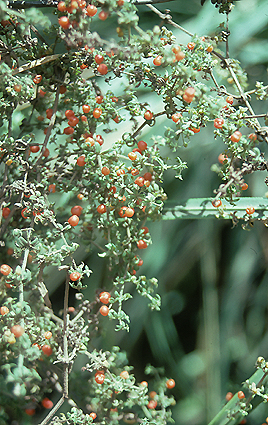Rubiaceae of the New World
By Piero Delprete and
Rocio Cortés
GALIUM Linnaeus
Rubiaceae of the New World
By Piero Delprete and
Rocio Cortés
GALIUM Linnaeus

Galium hypocarpium Photo P. Delprete Santa Catarina, Brazil |
Synonyms: Aparinanthus Fourreau; Aparine Guettard; Aparinella Fourreau; Bataprine Nieuwland; Galium sect. Relbunium Endlicher; Relbunium (Endlicher) J. D. Hooker; Trichogalium (A. P. de Candolle) Fourreau
Erect, sprawling, or climbing, annual or perennial herbs, or subshrubs; raphides present; axillary thorns absent. Stipules resembling the leaves, commonly of same shape and size of the leaves, persistent. Leaves whorled (including the stipules), commonly 4 (rarely 6–8) per node, subsessil or sessil; blades ovate, narrowly ovate, narrowly elliptic, elliptic, oblong, lanceolate or linear, membranaceous, chartaceous or stiffly chartaceous; foliar pellucid glands absent; domatia absent. Inflorescence axillary or terminal, frondose, paniculate, densely to sparsely branched or cymose and pauciflorous to multiflorous, or uniflorous. Flowers bisexual or morphologically unisexual (staminate and pistillate flowers on separate individuals) or functionally unisexual (staminate and pistillate flowers on separate individuals) or unisexual and bisexual on the same individual (polygamous-monooecious); bisexual flowers protandrous. Calyx tube absent with lobes free at base, or tube extremely reduced with small lobes, caducous; lobes (3) 4 (5), lanceolate, narrowly ovate or ovate, minute. Calycophylls absent. Corolla campanulate, urceolate or rotate, actinomorphic, white to cream-white, greenish-white, yellow, yellowish-white, pink, red or maroon; tube externally glabrous, internally glabrous, pubescent or hispid, without a pubescent ring inside; orifice annular thickening absent; lobes (3) 4 (5), valvate, ovate, margin entire, rounded at apex. Stamens alternate to the corolla lobes, exserted just beyond the corolla, anthers elliptic or oblong, round at base, round at apex, dehiscing by longitudinal slits, dorsifixed near the middle; filaments attached near the mouth of the corolla tube, free at base, filiform, long, longer than corolla tube, equal, glabrous. Styles two, sometimes united at base, terete throughout, not fleshy, glabrous, lobes absent, stigmatic surface located at style apex. Ovary inferior, 2-locular, ovoid; placentation axile, placenta reduced, ovules centrally inserted, 1 per locule. Fruit a schizocarp, splitting into 2 dehishent cocci, thinly woody, or a berry with fleshy mesocarp. Seeds horizontal, minute, dorsally convex, attached to the pericarp; wings absent.
Geographic distribution: Northern Central America (up to southern Mexico), southern Central America, West Indies, Magdalena-Llanos area, southwestern Amazon Basin, Guayana Shield, northeastern Brazil, Brazilian Atlantic coast, Brazilian planalto, Rio Paraná drainage, northern Andes (above 1000 m), central Andes, southern intertropical Andes, extra-tropical North and South America. A cosmopolitan genus of about 300 species.
Number of species: 62.
References: L. T. Dempster, The genus Galium (Rubiaceae)
in Mexico and Central America. Univ. California Publ. Bot. 73: 1–33. 1978;
L. T. Dempster, The genus Galium in South America. Allertonia 2(4):
247–278. 1980; 2(8): 393–426. 1981; 3(3): 211–258. 1982; 5(3): 283–344.
1990.